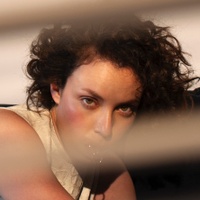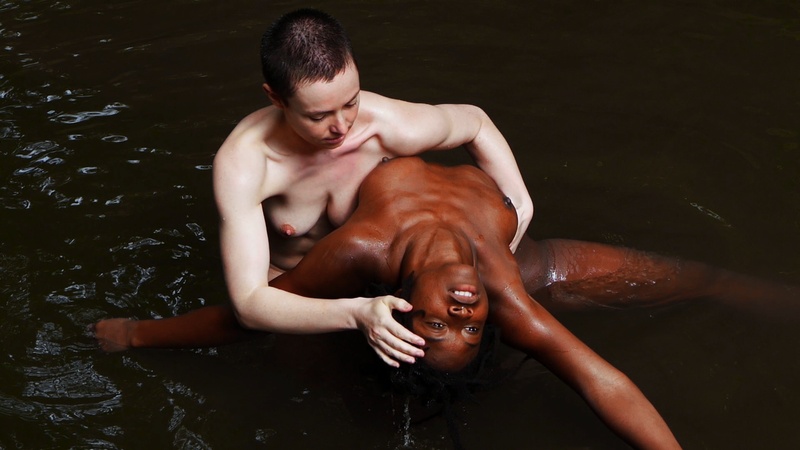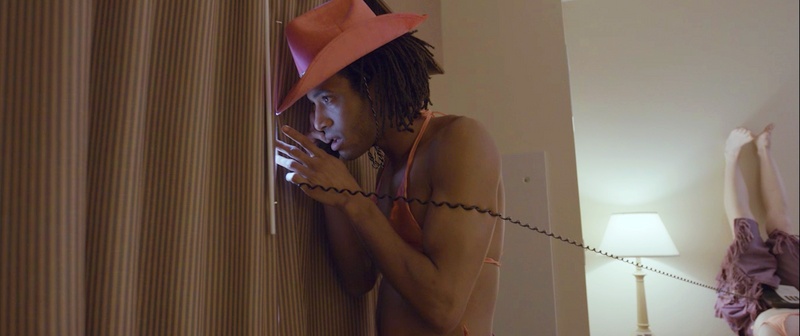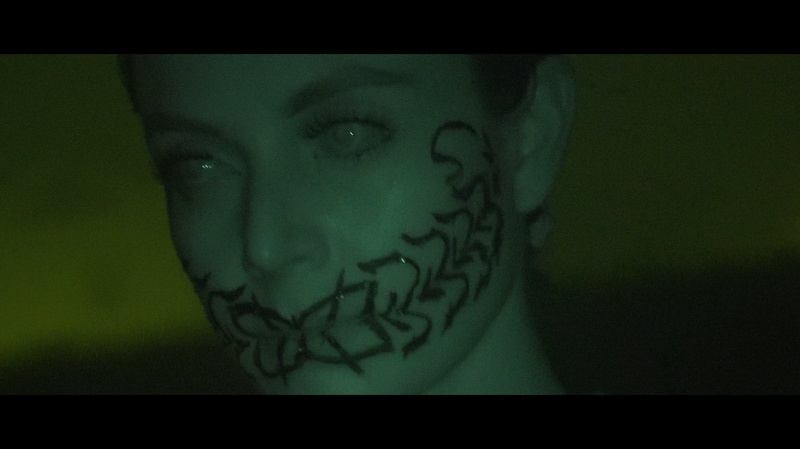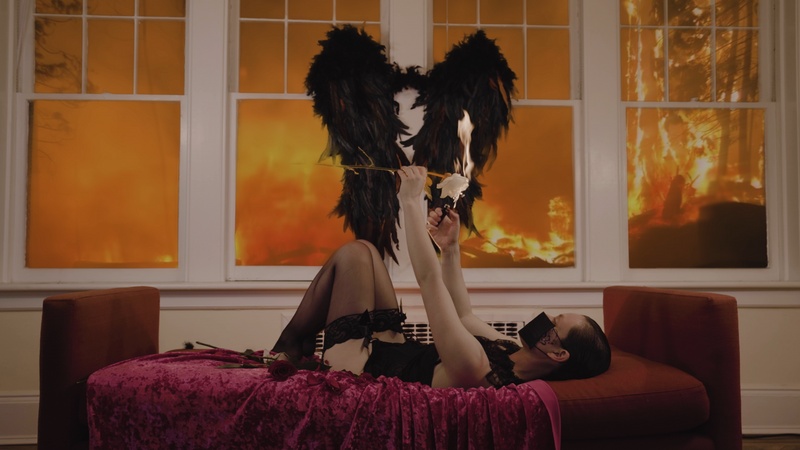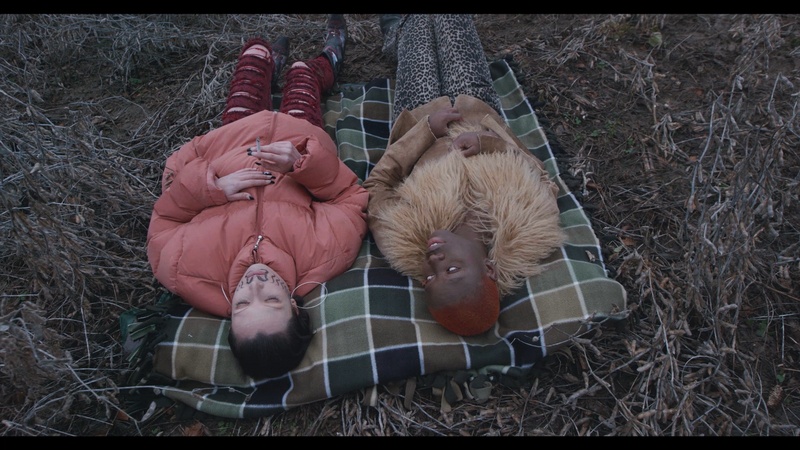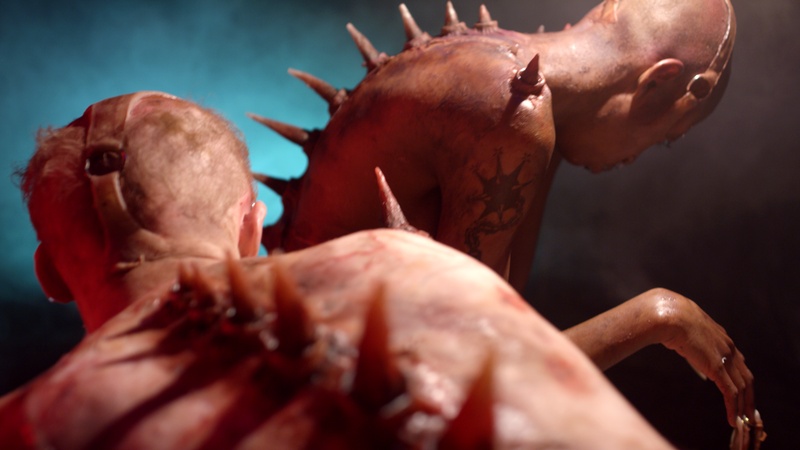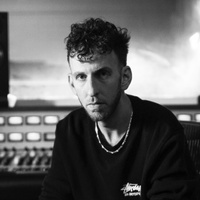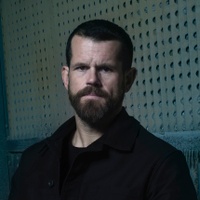As told to Brandon Stosuy, 3481 words.
Tags: Film, Process, Adversity, Production, Money.
On world building
Director Kathleen Dycaico on the complicated, collaborative experience of making music videos, the different ways one can view success and failure, and why sometimes you don’t fully understand what you’re making until after you’ve made it.You have a background in landscape architecture, and you’re a dancer and direct videos. These vocations feel connected, an overall aesthetic system for a creative world. You did dance first. Was directing videos always part of the plan?
It was not always the plan. The landscape stuff came out of the fact that I’ve always been interested in world building. I grew up reading sci-fi and fantasy and being obsessed with certain exploratory type computer games that were very much like a whole world—Riven and Myst and this weird dark Alice in Wonderland one.
With video you can control everything so much more than with a live performance, so you can plan for things to happen. The beauty is the chaos of what ends up happening. Things still do happen chaotically in video, but then you have the edit to decide how that’s going to be viewed, and you can take it into a whole other world.
I started doing video after showing a piece at MoMA PS1. After making that first video I realized the structure of how you make videos is attractive to me—as opposed to open-ended collaborations where nobody really knows who’s supposed to be in charge, or whose wheelhouse is what. That feels stressful to me and I’m trying to take the stress out of the process and instead put the emotional content into the product.
from LEYA’s Sister video
from Heartbreak Rodeo
I studied studio art before landscape architecture. Part of it was the pull between feeling frivolous and wanting to help people. “I’ll use landscape as this artistic way to design better worlds.” I have a desire to help, and I think that was my weird compromise. I don’t think it was ever going to be the right thing, but yeah, I was thinking of making a world for the people—like a little fishbowl.
When you’re making a video is it collaborative? Do you have to be in charge to make it work properly?
It depends on what the set-up is. For example, I feel like you can do a more collaborative one where it’s about the alchemy of you and the other person’s energy and that’s what’s driving it. Or—with music videos especially—someone can send you their track, which is a world that they built sonically, and you can channel that visually. I’ve done that with a couple of different music videos, and in that sense you have more control and it feels collaborative, but in a way where you both have your own separate zones. The other way is cool, too. It’s messier. And finding out where you want to make those compromises, depending on who you’re working with and where they want to make them, it’s just more thought put into the relationships as opposed to actually making the video happen.
What’s the biggest challenge with making videos? Money?
Money’s always such a struggle with everything that I almost don’t think about it. Like, it’s a given. I’ve been really lucky to be able to work with a lot of amazing people and I feel like every time in my life when I want to do something that’s really ambitious, like a big project, people will really come out of the woodwork and it feels very divine or crazy. Someone you don’t even know at all suddenly shows up and literally is the one that makes the entire thing happen.
That said, I think the relationships can be complicated. I always try to communicate very clearly, but sometimes people don’t realize how expensive videos are to make. They’re much more expensive than you would imagine. I think that can be a surprise.
Also, losing control is hard for people. Once you start doing your video project, even as the director, you do lose it a little bit. You have the general, overall vision, but everyone’s putting in a little bit. If someone is really used to working alone and being in charge of everything, and then they want to make a video, it can be uncomfortable for them. You’re basically giving that to someone else; you’re giving that control away. And so, if you don’t like that feeling, it’s going to feel scary for you.
When I first saw your work, you were dancing in a project directed by Sarah Kinlaw. You were being directed, as opposed to directing. Do you find one easier than the other?
I like to have them both happening at the same time. I think it’s a good balance, and when I have one and not the other, I can be a little off. When they’re both happening at once, when I’m putting a lot into a project that is my project and at the same time a project that is someone else’s, it feels more balanced. I just started rehearsals for a black metal opera. I’m one of the two people in it. So I was working on that project and the Rabit x Boy Harsher video at the same time. I’d put everything into the video and then would go to a rehearsal with Hunter Hunt-Hendrix, who is directing the opera, and really enjoy it as: “I feel invested in this. I feel I can have ideas, but it’s not mine. You just tell me what to do, because I’ve already used all my decision-making capacity for the day.”
from Boy Harsher x Rabit L.A. Remix
More and more people don’t specialize in one thing. Does doing a bunch of things come out of creative curiosity, or is it more of a practical thing, where this project supplements that one, and it helps you piece together an overall way to make a living?
I’ve always been a jack of all trades. When I was growing up, I played every sport. I love new things and learning things, but I do feel like video for me is a really good fit. As much as I feel adventurous, I’m also someone who really enjoy clear structure and being able to act from there. I think it is nice to come at things from different angles. Like, I want to make a graphic novel based on the characters in my videos. Why? If I saw a story that I designed, framed out in the way that comic books present things, then I could also use that the next time I go back and make a video. It would help me think about the framing in more of a graphic way, as opposed to a narrative way. Things all feed into each other, and that’s really exciting.
Do you get creative blocks?
Not right now, because at this moment that I’m talking to you, I feel like every day there’s something happening. This isn’t always the case. And, the creative blocks that I get are only ever because of self criticism or fear. For two and a half weeks I’ve been sleep deprived, hung over, and in love. But, in a way, it’s good. You can’t care too much, or as much as you would, or get as amped up as you would about each thing, and so it’s like you’re sliding in a little bit unprepared and like “It’s going to be what it is.” So, in a way it helps it all go and keep moving if you are working on different things.
** How do you avoid burning out when you’re doing a bunch of different projects?**
The only time I feel burnt out is when it’s emotionally stressful, when there are interpersonal conflicts in a project. That bums me out and makes me feel like I don’t want to do it, and it’s not worth it, and people don’t respect you, all of that stuff. If it’s just tiring—normal tiring, something that takes a lot of work—I don’t care because I feel excited about it.
Also, recently, before this video started, I had this very dark-night-of-the-soul moment. It was hard, but it helped me. It was really horrible in a way, but I also feel like when you have something so intense, an emotional state, that it’s clarifying because you realize that there’s absolutely no reason to do anything that you don’t actually want to do. In a core way, it could be hard to execute it, but if you want to make a project for the money or anything else, you can just cut that out right now. So I feel in that way it’s helpful because I feel like I’m clear about the things that I want to do. You don’t have to waste time putting a bunch of energy into something that you’re not excited about.
I had this intense understanding of the climate crisis, and the ending of the world, in a way I hadn’t before. That’s a hard one because it’s difficult to imagine your future at all—and, everything, the way that you grow up, or the things that you thought you would have or even just goals—when it’s all probably, maybe not going to happen. It’s just so sad that the place that you’re energetically a part of, that’s this living breathing thing is dying all around you. With that in mind, it’s really hard to have goals.
from Boy Harsher x Rabit L.A. Remix
There’s part of me that thinks it’s not worthwhile to care in that way, and that you should just accept that it is what it is and not spend time crying over spilled milk, and figure out what this life is going to look like. But it’s also hard to grieve an idea of what our world is supposed to be like.
Part of being creative, I think, is creating temporary spaces that can feel separate from the rest of the world that’s burning out there, around you—creating a positive world within a shitty world, even when you know it won’t last.
Or just a connection, even. I don’t know if videos are so escapist in that way because they’re so short, but I do feel like when people have told me that they’ve connected to something, that feels really good because we live in such a splintered world right now. The world is fragmented, so just to feel like someone has understood something that you made, it’s like you were there together. It is a very important feeling. So maybe these things—art, etc—are the things that we’re trying to protect, they should still go on, even if it seems like it’s not the most pressing item at the moment.
What do you consider being successful?
I think there are always little things that could have been better. It’s usually to do with time, it’s usually like, “Well we only had two weeks to make the entire thing, and it’s due.” But I really value these temporary, autonomous zones or little worlds that you build, and the crew of people that I’m making it with is super important to me. If the shoot feels good and it feels like everyone was working hard, good at their job, respected, excited, to me that’s a successful experience.
The product is important too, having the video out. But making the video, that time, is special. I always think about making a film like running with sled dogs—you’re all in the thing and you’re all running side by side, you’re not sharing the same body, but you’re all pushing towards the same thing. That feels successful to me. I think when people resonate with it and care about it, when someone feels the same thing that you feel, I think that feels successful to me. I think you’ve just got to keep doing it.
Do you think it’s okay to abandon a project? If you start something and it’s not going the right way, would you ever walk away from it, or do you try to finish things? Or can you learn something from it and then be like, “All right, this didn’t work, but I can use that later on?”
I think both ways could work. Things shouldn’t be easy, but there should be an energetic flow, and if it feels like you’re just making it to make it, or something like that, I don’t find value in that. Again, because the process is so important to me. But, I will say that sometimes it’s good to push through.
The new Boy Harsher video was the first idea that I came to them with, but at that moment there was no time and no money. They were like, “We want to do a cam girl session, and continue the character from the last video,” and I agreed. And it evolved into: I was going to go this live Chaturbate session, and I would be performing poetic actions, and people could log on and write on the side, so it makes a poem. I was going to ask all these poet friends of mine to go on and write and then whoever else comes on to the chat, you know, you don’t know. And it’s totally anonymous, so I think it’s a cool social experiment because people can say whatever they want. So we were going to that, but the morning of the shoot, they canceled and decided in a different direction.
I wasn’t going to do any video at that point because it was due in five days, and we’d just canceled the idea. They were like, “Let’s go back to the first idea.”
I didn’t think it was possible to complete a video in that timeframe but Jae of Boy Harsher pushed me to try, and I’m really glad I did. These three boys—a photographer, a video editor, and a graphic designer, people that I didn’t know before this—are on board to make this video happen. We were shooting it in their house, and their house was torn apart. We green screened all their windows. I’m there at 10:00 at night making them stay up at 8:00AM every day, dragged to the beach and we end at sunrise. And they’re just down to do it for some reason, and we made this video. So it was good. They made me push through it even though I was like, “This is too crazy.” The hectic, chaotic energy of actually making it in this way was really valuable and became very much a part of making it.
Do you see these videos as part of a larger artistic practice where eventually it will be like, “Here are these 30 videos that are all connected”?
Definitely. Everything is related, and I always feel like I’m just making the same thing over and over again. I’ll see something and be like, “Oh you know what I should do.” And then I’ll realize, “Oh, I basically did that three years ago,” which is a weird thing to say because I feel like everyone’s so into change and evolution. But, honestly, I feel like I’m circling back to the same things all the time, and I think that will come through regardless.
from Boy Harsher L.A.
A few years ago, I built this totally black church at Stream Gallery with fake walls so there could be light boxes at the chapel windows. I had that open as a totally unentertaining space, nothing happened in it. There’s a little room, and then there’s pews that I made and in the front it was just flowers. You could come and go and spend time there—everything was black and really calming. You could light a candle. That was open for six weeks. Then I had people come and completely destroy it with me. When we were smashing the walls, the black walls were cracking and the light was starting to come through from the light boxes. I feel like that is the same shit that I make over and over again. I don’t know, it’s always the same in a weird way, where I’m like, “Get another idea, Kathleen.”
You’re part of a scene with people like Sarah Kinlaw and Eartheater and FlucT. It’s a scene that combines music and dance and visuals—and it feels very vital to me. Does this feel like a movement to you, or are you just making things with your friends? Which, also, is a movement, all said.
I’m always inspired by my friends. Even just the verbal process, the talking. I never know what I’m talking about until it’s already happening, so if I didn’t move to New York and know the people I know now, I don’t think I would be doing this. I’m not a hermit-type artist who’s just like, “I don’t care, I’m just going to paint in this room for 30 years, it’s satisfying.” The artistic exchange of our community is really incredible. I feel really lucky.
How much of it is completely figured out by the time you start shooting a music video?
With a music video, you usually send a treatment—it’s a deck with all these images and writing about what happens. Creating the treatment is a helpful way to also understand what you’re talking about. Then you start to see, “Okay, I’m drawn towards these colors for this, it looks like, because everything right here is red,” or whatever. It reflects, again, the little circle of the writing and reading and then someone else saying something that you hadn’t thought of and you’re like, “Oh, it is about that.”
from QUALIATIK Mother Tongue
Then there’s the process of making a video. It’s usually very structured and I think that it really helps if you: have a general idea, have your treatment, and kind of know what’s going to happen. Now you have so make your shot list. So it’s not like, “Ok, well, let’s get some stuff of them talking.” It’s like, “We get the wide shot, and then we get this, then we get that.” You just keep going down and cutting time into smaller and smaller chunks. Understanding what you’re going to do with the time is important, especially if you’re trying to make a story. It’s harder when you’re not trying to make a story and I don’t usually make non-narrative videos. I don’t understand how to edit something like that because I don’t know what’s supposed to happen at any time.
It’s a weird, interesting way of understanding time and story, and of meaning-making. It’s nice to be able to look back on things, because that’s how I feel like I understand everything that I make anyway. I’m never trying to say something the way that other artists might. Some people are like, “I’m going to make this and it’s going to be about this and this, and it’s going to tell people this.” And I’m drawn towards things where I feel like there’s something that comes intuitively and then I look at it after the fact and I’m like, “Oh, now I see.” Which is cool, but it feels very loose.
With video, you have to explain the concept to lots of other people before it gets made, so you can’t just say, “I don’t know, trust me.” So I understand the backbone of it, but certain symbols or certain patterns, surface later. Afterwards I’ll be like, “Oh, that does stand for that.” Sometimes I think about them like weird horcruxes, from Harry Potter. You make one about something and put that little, weird painful thing into it, and hopefully it stays in the video. Sometimes they cut it, and hopefully when they do, it doesn’t split your soul.
from QUALIATIK Mother Tongue
Recommended by Kathleen Dycaico:
1) “The Presence Process” by Michael Brown
A 10-week meditation mantra practice developed by the author while living with a chronic pain condition; can be cheesy but maintains the focus
2) “Meditations” by Marcus Aurelius
Spiritual reflections to cut through anything
3) “The House is Black” dir. Forough Farrokhzad
Poetic short documentary film by Iranian director Farrokhzad; the only one completed before her death
4) “We’re Doomed. Now What?” video by Roy Scranton
Author of Learning to Die in the Anthropocene
5) Sci-fi and fantasy by Orson Scott Card, Garth Nix, William Gibson :)
6) Channeling excess energy / working out is the main & only thing for me. Train with Flux Vitality if you’re in NYC

